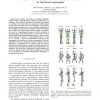Free Online Productivity Tools
i2Speak
i2Symbol
i2OCR
iTex2Img
iWeb2Print
iWeb2Shot
i2Type
iPdf2Split
iPdf2Merge
i2Bopomofo
i2Arabic
i2Style
i2Image
i2PDF
iLatex2Rtf
Sci2ools
114
click to vote
ICRA
2010
IEEE
2010
IEEE
Learning and planning high-dimensional physical trajectories via structured Lagrangians
— We consider the problem of finding sufficiently simple models of high-dimensional physical systems that are consistent with observed trajectories, and using these models to synthesize new trajectories. Our approach models physical trajectories as least-time trajectories realized by free particles moving along the geodesics of a curved manifold, reminiscent of the way light rays obey Fermat’s principle of least time. Finding these trajectories, unfortunately, requires finding a minimumcost path in a high-dimensional space, which is generally a computationally intractable problem. In this work we show that this high-dimensional planning problem can often be solved nearly optimally in practice via deterministic search, as long as we can find a certain low-dimensional structure in the Lagrangian that describes our observed trajectories. This lowdimensional structure additionally makes it feasible to learn an estimate of a Lagrangian that is consistent with the observed trajectori...
| Added | 26 Jan 2011 |
| Updated | 26 Jan 2011 |
| Type | Journal |
| Year | 2010 |
| Where | ICRA |
| Authors | Paul Vernaza, Daniel D. Lee, Seung-Joon Yi |
Comments (0)

